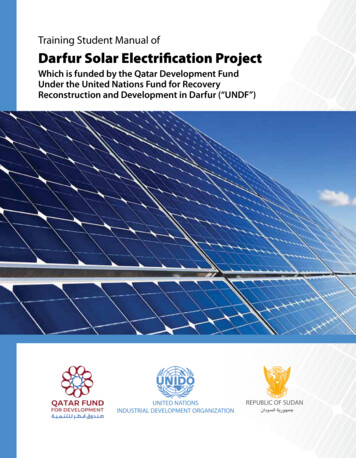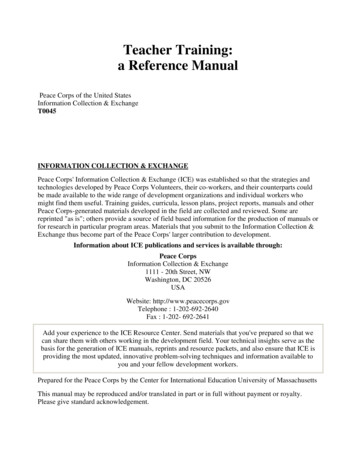
Transcription
Training Student Manual ofDarfur Solar Electrification ProjectWhich is funded by the Qatar Development FundUnder the United Nations Fund for RecoveryReconstruction and Development in Darfur (“UNDF”)REPUBLIC OF SUDAN جمهورية السودان
This Student manual of Darfur Solar Electrification is a project fundedby the Qatar Development Fund under the United Nations Fundfor Recovery Reconstruction and Development in Darfur (“UNDF”)this project has been implemented by the United Nation IndustrialDevelopment Organization UNIDO and the National EnergyResearches Center.The manual has prepared byDr. Azmi Taha, UNIDO National Consultant. Contribution andcomments were gratefully acknowledged from Solar PhotovoltaicexpertDr. Duncan Brewer, who provided significant support in preparingthis training manual.The Project manager isMs. Lorence Ansermet, Department of Agri-Business DevelopmentThe Project Associate isMs. Sabrina Gasperetti, Department of Agri-Business DevelopmentThe National Project Coordinator isMs. Aaza Badri, UNIDO Country Office in SudanPrinted By, Sinan International for PrintingThe United Nation Industrial Development Organization UNIDO is aspecialized agency that works to solve the most pressing challenges of ourtime by promoting and accelerating inclusive and sustainable industrialdevelopment (ISID). UNIDO believe that green industry is at the heart ofsustainable growth that encompasses all countries and all people.AddressUNIDO- United Nation Industrial Development OrganizationSudan Country OfficeBuilding No.10 Khartoum EastStreet 25, Al AmaratKhartoum – SudanTel: 249-183-460342E-mail: office.sudan@unido.org
Introduction1. Resources1.1 Solar energy1.1.1 Apparent movement of the Sun1.1.2 Solar radiation1.1.3 The solar spectrum1.1.4 Solar radiation on Earth1.2 Factors affecting the amount of solar radiation on a solar module1.3 Measurements of Solar radiation1.3.1 Pyranometer1.3.2 Pyranometer1.3.3 Reference cell1.4 Practical exercise No. 1, Measurement of the intensity of solarradiation1.5 Database of solar radiation in Sudan2 Measuring devices2.1 The AVOMETER (AVO):2.1.1 Analogue AVOmeter2.1.2 Digital AVOmeter2.2 Thermometer2.3 Clampmeter2.4 Practical exercise No. 2, How to use the AVOmeter2.4.1 Introduction2.4.2 Measuring voltage difference2.4.3 Current measurement2.4.4 Resistance2.5 The Oscilloscope2.6 Exercises3 Conversion of solar energy into a useful energy1.3 Thermal conversion3.2 Photovoltaic conversion3.3 Exercises4 PV solar cells4.1 Photovoltaic Cells (or solar cells):4.2 Making a photovoltaic cell4.3 Types of solar cells4.4 Electrical diagram representing a photovoltaic cell4.5 719191920212121232427Darfur Solar Electrification ProjectTable of Contents1
Darfur Solar Electrification Project256789PV solar modules5.1 Construction of a module5.2 How to put solar cell panels (orientation of modules5.3 Practical exercise No. 3, wiring of solar modules5.3.1 Parallel strings of modules5.3.2 Series strings of modules5.3.3 Series-parallel strings of modules5.4 ExercisesPV Solar systems and applications6.1 Layout of the general solar system and its components6.2 Applications6.3 ExercisesStorage batteries7.1 Energy Storage in PV systems7.2 Battery terms7.3 Internal construction of a battery7.4 Types of a batteries7.4.1 Leadacid Batteries (Liquid Batteries)7.4.2 Dry Batteries7.5 Practical exercise No. 4, Acid Filling and Connecting Batteries7.6 Categories with Depth of Discharge (DOD):7.6.1 Shallow Discharge7.6.2 Deep Discharge Batteries7.7 General maintenance7.8 Charging7.9 Practical exercise No. 5, bonnection of Batteries7.10 Different factors affecting Battery Performance7.11 ExercisesBattery Charge Controllers8.1 Definition8.2 Types8.3 Practical exercise No. 6, Connection of Battery Charge Controllers8.4 ExercisesDC – AC Inverters9.1 Introduction & Definition9.2 Inverter Wave Forms (Types of DC-AC Inverters)9.2.1 Sine-wave Inverters9.2.2 Modified Sine-wave Inverters9.2.3 Square-wave 1414243434344464949495053545454555656
69707171727272737373747476Darfur Solar Electrification Project9.3 Protection of Inverters9.4 Technical specifications of the Inverter (Terms):9.5 Exercises10 Selected Applications of PV solar energy10.1 Examples of solar energy use include10.2 Using solar cells in Telecommunications10.3 Solar pumping10.4 PV solar refrigerators for vaccines10.5 Practical exercise No. 7, On PV Systems (demonstration or site visit)10.5.1 PV solar lighting systems10.5.2 Battery charging by PV modules10.5.3 PV solar pumping systems10.5.4 PV solar refrigerators10.6 Exercises11 Advantages and disadvantages of solar energy11.1 Advantages of solar energy11.2 Disadvantages of solar energy11.3 Exercises12 System Sizing, Installation and Maintenance12.1 Different Loads on a Photovoltaic system12.2 PV System Design12.2.1 The Daily Energy Requirement Worksheet12.2.2 Photovoltaic System Components choice12.3 Sizing the battery12.4 Sizing the power source, solar modules or array12.5 Sizing the voltage controller (Regulator):12.6 Sizing the Inverter12.7 Choosing the right site for your solar array12.8 Mounting modules to a support structure12.9 Wiring modules together12.10 A place for Power-Conditioning equipment12.11 Wiring Power-Conditioning equipment together12.12 Wiring the Inverter12.13 Battery safety12.13.1Adding electrolyte to Batteries12.13.2Wiring Batteries Together12.14 System maintenanceReferences3
Darfur Solar Electrification Project4Introduction:Solar energy received on the earth surface in form of solar radiation that humanshave harnessed and utilised since ancient times using a range of different ever-evolvingtechnologies. Over the past few years, the solar energy sector has grown by about 50%per year, faster than any other energy source, and the equipment price has fallen bymore than 80% since 2005, making solar energy more competitive with oil, gas andnuclear power. Increasing interest in solar energy and the expansion of its use requirerehabilitation and training of human resources capable of dealing with these systems.This textbook entitled “Solar PV Systems Technology” is dedicated to the third-gradeengineering course (track) students in technical secondary schools. The book haseleven modules; the first module is concerned with the concepts of solar energy and itsresources. The second module deals with the measuring devices. The following threemodules deal with the conversion of solar energy into electricity using photovoltaic(PV) solar cells and PV solar modules, defining their technical specifications andexplaining their methods of wiring and connections. Modules six to nine introducethe general layout of PV solar systems and its components discussing in detail theStorage Batteries, the battery charge controllers and the DC-AC Inverters. Module 10presents some selected solar energy applications, advantages and disadvantages ofusing solar energy. The last module gives the concept of system sizing, installation andmaintenance.This book is designed for use by anyone who is interested in developing his/herknowledge and technical capabilities in the field of photovoltaic solar systems. Thebook is targeted to specific people wishing to engage in the supply, installation,operation and maintenance of the different components of photovoltaic solar systems.
1.1 Solar energy:The Sun is the main source of energy on our planet. It is the source of all otherenergies such as fossil fuels, wind, tides. The Sun produces its energy through theinteraction of nuclear fusion.1.1.1 Apparent movement of the Sun1. The Earth revolves around the Sun, but it appears to us that the Sun movesacross the sky from the east to the west.2. The earth also revolves around its polar axis and the axis is inclined at 23 .3. The position of the sun is defined by two angles; the azimuth and the height.HeightNORTHAzimutWESTXEASTFigure 1: Show path of the Sun across the sky.1.1.2 Solar radiation1. Our Sun is a relatively small star, a hydrogen fusion generator, an enormousincandescent sphere, the source of all life on Earth.2. Solar radiation is the electromagnetic radiation emitted by the sun and arrivingon the surface of the Earth.Darfur Solar Electrification Project1. Resources:5
Darfur Solar Electrification Project61.1.3 The Solar spectrum1. The Solar Spectrum is electromagnetic radiation made up of a range ofwavelengths.2. Ultraviolet 9%3. Visible 47%4. Infra-Red 44%1.1.4 Solar radiation on Earth1. Direct radiation, clear sky, a surface inclined directly to the sun2. Diffused radiation- the radiant energy from the whole sky, reflection from clouds.3. Ground Albedo- radiation reflected by the ground, related to the nature of the ground.Usable Quantities of Solar Radiation1400 W/m2Above theAtmosphere1000 W/m2At Ground Level 100 W/m2 Conversionby photovolaic Modules500 W/m2 Thermal CollectorFigure 2: usable quantities of solar radiation.1.2 Factors affecting the amount of solar radiation on a solar module:1.2.3.4.5.6.7.Latitude at location (height angle).Season of the year.Amount of sunlight (clouds, dust).Temperature.Hour of the day (azimuth angle).Module construction.Other factors.
SUN23oSummer Equinox(June)Winter Equinox(December)Figure 3: Show the earth’s rotation around the sun (season).1.3 Measurements of Solar radiation.Solar radiation measuring devices:Generally, there is a need to measure solar radiation. The solar radiation measurementis based on the number of hours of sun brightness a day. From these values, averagemonthly and annual rates are calculated, in addition to the strength of solar radiation.Several devices are available to measure the solar radiation intensity at the surface ofthe earth, include: The Pyranometer.Solarimeter.Darfur Solar Electrification ProjectSeason of the Year (affects sunlight angle on the array)7
Darfur Solar Electrification Project1.3.1 Pyranometer8Figure 4: Show Pyranometer1.3.2 PyranometerFigure 5: Show Solarimeter
Darfur Solar Electrification Project1.3.3 Reference Cell9Figure 6: Show a reference cell.The instantaneous solar radiation power is measured in watts per square meter (W/m ) which represents also the energy received per second per square meter.The daily-accumulated energy received from the solar radiation is measured inmegajoule per square meter per day (MJ/m2/day) or in kilowatt-hour per square meterper day (KWh/m2/day).21 KWh/m2/day 3.6 MJ/m2/day
Darfur Solar Electrification Project1.4 Practical exercise No. 1, measurement of the intensity of solar radiation1.5 Database of solar radiation in Sudan:The table below shows the average daily solar radiation in megajoule per squaremeter per day (MJ/m2/day), for the different months of the year, measured in differentlocations.Table 1: The monthly average of total solar radiation is shown in MJ / m2 / dayMonth10JanuaryFebruaryMarch أ 21.3921.2320.3521.6From these data, it appears that Sudan is rich in the resource of solar energy thatcan be converted into a useful source of energy.
Darfur Solar Electrification Project2. Measuring devices:2.1 The AVOMETER (AVO):It is a device to measure the current, the voltage and the resistance.There are two types, the analogue Avometer and the digital Avometer.2.1.1 Analogue terminal)20A DConly(1 DC 20A 100D 10CV 25COM 102.5NegativeteminalRangeselector10OFF1001k20AOhm (Ω(calibrationknob100250 A25 CV10250mADCA PositivetterminalTest Lead (Black(Test Lead (Red(Figure 7: Show Analogue Avometer.11
Darfur Solar Electrification Project2.1.2 Digital AVOmeter:1211POWEROFFON10312948COM5729066Figure 8: Show Digital AVOmeter.Keterangan:1. 312 digit display (1999 maximum) with automatic decimal pt. and minus sign.2. POWER switch.3. Function Range Switch.4. LOGDC Indicaters: Red LED logic high, green LED lower.5. W-OHM Jack: Input for dc or ac voltage, resistance, or continuity.6. COM Jack: Input for common or reference test lead forall measurements.7. mA Jack Input for dc or ac currents up to 200 mA.8. 10 A Jack: Input for currents up to 10 A.9. TEMP TYPE K Jack: Input for Type K thermocouple.10. hFE Jack: Input for direct insertion of npn or em transistor leads.11. LOGIC Jack: Inputs for three pin logic test leads.Figure 9: Show Keywords Analogue AVOmeter.
The device that measures the temperature. And temperature measurement unit ( Cand F).Darfur Solar Electrification Project2.2 Thermometer:13Figure 10: Show Thermometer.Figure 11: Show Digital Thermometer.
Darfur Solar Electrification Project14Figure 12: Show Thermo Sensor.2.3 Clamp meter:It is the type of Avometer that measures current without disconnecting the circuit,particularly high values of current.3910114COM بنانة لتوصيل الطرف -7L1/Ω/ بنانة لتوصيل طرف قياس الجهد -8L3 بنانة لتوصيل طرف القياس -9 ضاغط لقياس الرتدد -10. ضاغط إلظهار آقل واقىص قيمة للقراءة -11HOLDL1F400 OFF400 40 OFF400HOLDVL1)R(6A100040060040COML2 )S(PhaseMAXVPEAKMAXM NHz L3)T(8251. ـ فكا الجهاز 1. ضاغط لفتح الفكني -2.LCD شاشة العرض -3. ضاغط لحفظ القيمة العظمى -4. ضاغط لحفظ املعلومات التي عىل الشاشة -5. مفتاح اختيار دوار -6Figure 13: Show Clamp meter.
Darfur Solar Electrification Project15Figure 15: Show Digital Clamp meter.Figure 14: Show Analog Clamp meter.How to use the Avometer:1. Potential difference measurement.2. Current measurement.3. Resistance measurement.2.4 Practical Exercise No2, How to use the AVOmeter:2.4.1 Introduction:When using the AVOMETER, the indicator (in the middle of the device) should bemarked to indicate the object to be measured (voltage, current, resistance) beforeusing it in the circuit, and any error, in this case, leads to damage to the measuringdevice. For example, the position of the indicator in the (ohm) and its use to measurethe difference of effort.2.4.2 Measuring voltage difference:If the device is used to measure the voltage difference, the device shall beconnected in parallel between the two points to determine the voltage between
Darfur Solar Electrification Project16them so that the negative terminal in the device connects with the negative pointand the positive terminal in the device with the positive point.2.4.3 Current measurement:When the AVOMETER is used to measure current intensity, it is connected inseries with the circuit at the point where the current is to be observed, consideringthe directions at the connection. If the electrodes of the AVO (negative and positive)are reversed at the conduction, the indicator will move in the opposite direction.This is in the case of mechanical AVO. In the case of digital AVO, the reading on thescreen is negative. In this case, the poles of the AVO should be reversed.2.4.4 Resistance:In the case of resistance measurement, the AVOmeter must be connected betweenthe two ends of the resistance without regard to negative and positive directions.2.5 The Oscilloscope:An oscilloscope is a laboratory instrument commonly used to display and analyse thewaveform of electronic signals. In effect, the device draws a graph of the instantaneoussignal voltage as a function of time.Oscilloscopes are used to observe the change of an electrical signal over time,such that voltage and time describe a shape, which is continuously graphed againsta calibrated scale. The observed waveform can be analysed for such properties asamplitude, frequency, rise time, time interval, distortion and others. Most oscilloscopescan only directly measure voltage, not current. One way to measure AC current with anoscilloscope is to measure the voltage dropped across a shunt resistor.Figure 16: Show Oscilloscope.
Question 1:Define the following terms:1. Instantaneous power of solar energy2. Clamp meter3. Oscilloscope4. Pyranometer5. SolarimeterQuestion 2:Answer briefly:1. Solar radiation reaching the earth is divided into:1. . . . 2. . . . 2. The cumulative energy of the sun depends on:1. . . . 2. . . . 3. Sun spectrum consists of:1. . . . 2. . . . 3. . . . 4. Write three factors that make solar energy variable in value and intermittent in its existence:1. . . . 2. . . . 3. . . . 5. Write three devices that are used to measure the current and voltage difference:1. . . . 2. . . . 3. . . . 6. Write three factors that affect the rate of future solar radiation by solar systems:1. . . . 2. . . . 3. . . . 7. The percentages of the components of the Sun spectrum are:1. . . . 2. . . . 3. . . . Darfur Solar Electrification Project2.6 Exercises:17
Darfur Solar Electrification ProjectQuestion 3:Draw a circle around a letter that has the best answer:1. A device used to measure voltage, current and resistance, and the indicator system isused when reading. In this case, the indicator should be set (at zero) before using it:a. Thermometerb. Oscilloscopec. AVOmeterd. Clamp meter2. The solar power per square meter is measured by:a. Voltageb. Ampc. Jold. Watt3. The sun reaches the Earth in the form of waves:18a. Photographicb. Magnetismc. Photoelectricd. Electromagnetism4. The best device to measure the intensity of solar radiation:a. Solarimeterb. Pyranometerc. AVOmeterd. Reference Cell5. The four seasons (winter, spring, summer, fall) are produced by the rotation of theearth around:a. Earth axisb. Sunc. Moond. Mars6. One of the most important measuring devices and electronic circuit testing iswhere we can see the signals at multiple points of circuitry:a. Thermometerb. Oscilloscopec. AVOmeterd. Clamp meter7. The maximum hourly daylight hours in Sudan ranges from:a. 8 to 10 hoursb. 10 to 12 hoursc. 12 to 14 hoursd. 10 to 14 hoursc. Kelvind. All answers are correct8. Temperature measurement system:a. Centb. Fahrenheit9. The spectrum of UV(Ultraviolet) rays from the spectrum of the sun represents:a. 7 %b. 9 %c. 44 %d. 47 %10. A device used to measure current intensity during the operation of the electriccircuit without having to separate the circuit and then reconnect it to another.a. Thermometerb. Oscilloscopec. AVOmeterd. Clamp meter
Solar energy can be converted into a useful form of energy in different ways. Twopopular types of converting solar energy are:3.1 Thermal conversion:Thermal energy technology is used to generate energy from the sun through solarcollectors (usually flat plates), which in turn generates heat energy ranging from lowto medium ready for direct use. One of the most popular uses of this energy is solarwater heating systems, swimming pools as well as cooling systems both in residentialand commercial buildings.3.2 Photovoltaic conversion:Solar cell technology is used to absorb and collect energy from solar radiationand convert light directly into electrical energy using photovoltaic effect. These cellsmanufactured using semiconductor materials such as silicon. They are also calledphotovoltaic cells (PV Cells).Darfur Solar Electrification Project3. Conversion of solar energy into a useful energy:19
Darfur Solar Electrification Project203.3 Exercises:1. What do we mean by “Conversion of solar energy”?2. Compare between Photovoltaic conversion and Thermal conversion.
PHOTOVOLTAICS indicates the followings:1. Photo - Light (solar radiation)2. Volt- Electricity3. Photovoltaic cells transform solar radiation directly into electricity4.1 Photovoltaic Cells (or Solar cells):1. The most common type of photovoltaic cells is made of sand. Sand is the silicaform of the element, SILICON.2. The first step in making a photovoltaic cell is to melt the silicon underextreme heat, remove the impurities and then re-crystallise it into a uniform(monocrystalline) or slightly non-uniform (polycrystalline) structure.3. The second step in making a photovoltaic cell is to add small quantities of othertypes of atoms to the crystalline structure. This process is called DOPING.4. If the other atom contains more electrons than the silicon atom, the structurewould acquire an excess of electrons. This is called N-type. This is a part of thephotovoltaic cell structure that has an excess of electrons, and therefore anoverall negative charge. A common doping material is PHOSPHOROUS.5. If the other atom contains fewer electrons than the silicon atom, the structurewould have a shortage of electrons. This is called P-type. This is a part of thephotovoltaic cell structure that has a shortage of electrons (sometimes called“holes”), and therefore an overall positive charge. A common doping materialis BORON.4.2 Making a Photovoltaic Cell:1. The N-type and the P-type silicon are brought together.2. When the two types of semiconductors are brought together, the N-P JUNCTIONis created.3. The N-P JUNCTION is an area of the photovoltaic cell where an electromagneticfield has formed. The electromagnetic field maintains the separation of thepositive charges in the P-Type layer and the negative charges in the N-typelayer.Darfur Solar Electrification Project4. PV solar cells:21
Darfur Solar Electrification Project224. The negative and positive charges balance each other at the N-P Junction.5. The phenomenon of making electricity with light is caused by the interactionof light with atoms in the photovoltaic cell.6. The sunlight varies in strength given its particular wavelength (ex. ultraviolet isstronger than infra-red).7. If the light is strong enough, it can release electrons in the photovoltaic cell andthese negative charges are free to roam around.8. A free electron is accelerated by the electromagnetic field at the N-P Junctionand is pushed up through the N-type layer.9. A voltage drop appears between the two sides of the N-P junction, and ifconnected to an external circuit, a current is induced. ELECTRICITY FROMSUNLIGHT!Solar radiation converted to electric charge movementHow a photovoltaic cell generates powerElectrodeLightLightLightAntireflection filmn-type siliconp-type siliconElectrodeElectricityFigure 17: Show How a Photovoltaic cell generates power.
Solar Cells are made of three different types of silicon namely: the first type ismonocrystalline silicon which can have conversion efficiency up to 25% and a lifetimeof more than 25 years.First Type:Darfur Solar Electrification Project4.3 Types of Solar Cells:23Figure 18: Monocrystalline Silicon Cell.Second Type:Figure19: Polycrystalline Silicon Cell.
Darfur Solar Electrification ProjectThird Type:24Figure 20: Amorphous Silicon Cell4.4 Electrical Diagram representing a photovoltaic CellElectrical Diagram representinga Photovoltage CellA diode in parallel with a photovoltaic cellI (Current)I photovoltaic cellI diodeVoltageFigure 21: Show solar cell circuit.
I Photo (v) - I Diode (v) I (v)I photovoltaicI DiodecellAmpsIV Curve photovoltaic cellI scAmpsVoltsGraph 1MaximumPowerPointVolts0.6 Volts Open CircuitGraph 2Graph 3Figure 22: Show how the current is calculated in the solar cell circuit.The voltage created by the creation of the N-P junction is .485 Volts, no matter howbig or how small the cell is.However, the amps that any one cell can produce is a function of the size of the cell. A10cm x 10cm photovoltaic cell (ex. PWX500) produces about 3 amps at 25 C (1000 W/m2).Current and Voltage Curves for a Single Photovoltaic CellCurrent and Voltage Curves for aSingle Photovoltaic CellShortCircuitCurrentIV Curve3.152.88Maximum Power Point(One Cell from a PWX 500@250 C)PowerSupplied1.36 WOpenCircuitVoltage0.472 V.6 VFigure 23: Show voltage and current curve.Darfur Solar Electrification ProjectElectrical Characteristics of a Photovoltaic Cell25
Darfur Solar Electrification ProjectGetting cells together1. After the N-P Junction is created, an anti-reflective coating is applied to the cell.2. After the anti-reflective coating, the thin grid of metal is applied to the top(18%) and bottom of the cell. These are the conductors for the electrons.3. Finally, the cells are connected with thin ribbons of wire.4. The Photovoltaic cell ready for placement in the Module10 cm26NegativeFRONTBACKFigure 24: Show solar cell front and backsides.
Darfur Solar Electrification Project4.5 Exercises:Question 1:Define the following terms:1.2.3.4.Solar CellSolar Cell CircuitMonocrystallineP-N JunctionQuestion 2:27Answer the following:1. Compare between Polycrystalline and Amorphous silicon2. What is the thing that increases the scalability of silicon crystal conductivity?5. PV solar modules:5.1 Construction of a module:A solar module is number of PV cells connected in series and/or parallel.The cells are encapsulated with the EVA and then a gasket and aluminium frame isput around the glass to seal it against the environment.GLASSEVAFRAMEGASKET36 CELLSRIBBONFigure 25: Show construction of solar panel.
Solar modules have the following specifications:1. Open circuit voltage between 17 to 20 volts.2. Module voltage when connected in a circuit is higher than 12 VDC.3. Module current depends on its surface, solar radiation and temperature. For100-Watt peak module it ranges between 4 and 6 Amp.4. At the back of any solar module, the manufacturers put a preamble thatspecifies the characteristics of the solar cell, which includes:a. Peak Power (Watt Peak ) Wp()b. Short Circuit Current )Isc(c. Open Circuit Voltage )Voc(Table 2: Module SpecificationsCodeModelPowerPeak (W)Vm (V)Im (A)Voc (V)Isc (A)50116FVG 50P5017,52,9022,003,20535351197Darfur Solar Electrification Project281.35GASKETFigure 26: Surface of Solar Module.
Darfur Solar Electrification ProjectSolar modules are produced in different powers, from 5 Wp to 400 Wp.The Watt peak (Wp) is electrical power delivered by PV module at a standardcondition, 1 KW/m2 solar radiation and at an ambient temperature of 27-degree C.29Monocrystalline PV ModulePolycrystalline PV ModuleFigure 27: Shape of solar PV modules.1. Electrical Diagrams of a PV module:Electrical Diagramsof a PV ModuleIPhotovoltaicModuleIVoltsVDuring the night, I O and thebattery discharges into the arryFigure 28: Show Electrical Diagrams of a PV module.
Darfur Solar Electrification Project305.2 How to put solar cell panels (Orientation of modules): Solar cell panels are placed southward in the northern hemisphere and placednorthward in the southern hemisphere at an angle of Milan equal to the latitudeof the site to be installed.The standard angles are:5, 10, 15, ., 25 degree The solar cells are placed where they will not get broken and there are noshadows like the shade of trees and buildings.It should be cleaned of dust and it is important to remove the barriers that blockthe sun periodically.cellmoduleFigure 29: Flowchart for cell transformation of a cell panel then a cellarray and then a solar generator.
5.3.1 Parallel Strings of modules:The amps add up while the voltage stays the same. veDarfur Solar Electrification Project5.3 Practical exercise No. 3. Wiring of solar modules31-----veFigure 30: Parallel connection.5.3.2 Series strings of modules:The voltage adds up while the amps stay the same.-ve- - - -Figure 31: Series connection. ve
Darfur Solar Electrification ProjectWiring Modules togetherIscPeak Power for 6 Modules3 Strings of 2 Modules in Series6.30 Amps3.15 Amps3221 Volts42 VoltsVocFigure 32: Show I-V curves of wiring modules.People should careful when connecting solar modules in series.One can get very high DC voltages, which is dangerous and can kill.5.3.3 Series- Parallel strings of modules:Always make your series connections first and then make your parallel connections.Wiring modules togetherIsolationDiodesBatterypositivePositionof BypassDiodesSix 12 Volt3 Amp SolarModulesBatteryNegativeString 1String 2String 3Figure 33: Show How to connect composite panels of solar cells.24 VoltDeepCycleBattery
Draw a ( ) mark in front of the correct answer and a ( ) mark in front of the wronganswer; and then correct the wrong answer:1. Solar cell panel is the smallest unit of solar cells commercially sold . ().2. In Home connection, total current intensity current intensity of one cell number of cells . ().3.It is preferable to use parallel connection in solar pumps used for water pumpingand some solar refrigerators.
this training manual. The Project manager is Ms. Lorence Ansermet, Department of Agri-Business Development The Project Associate is Ms. Sabrina Gasperetti, Department of Agri-Business Development The National Project Coordinator is Ms. Aaza Badri, UNIDO Country Office in Sudan The United Nation Industrial Development Organization UNIDO is a










